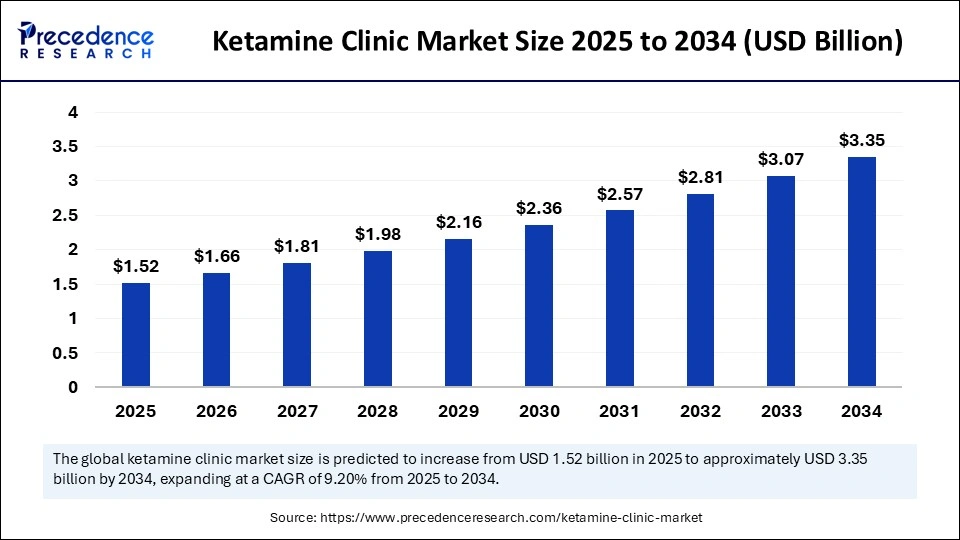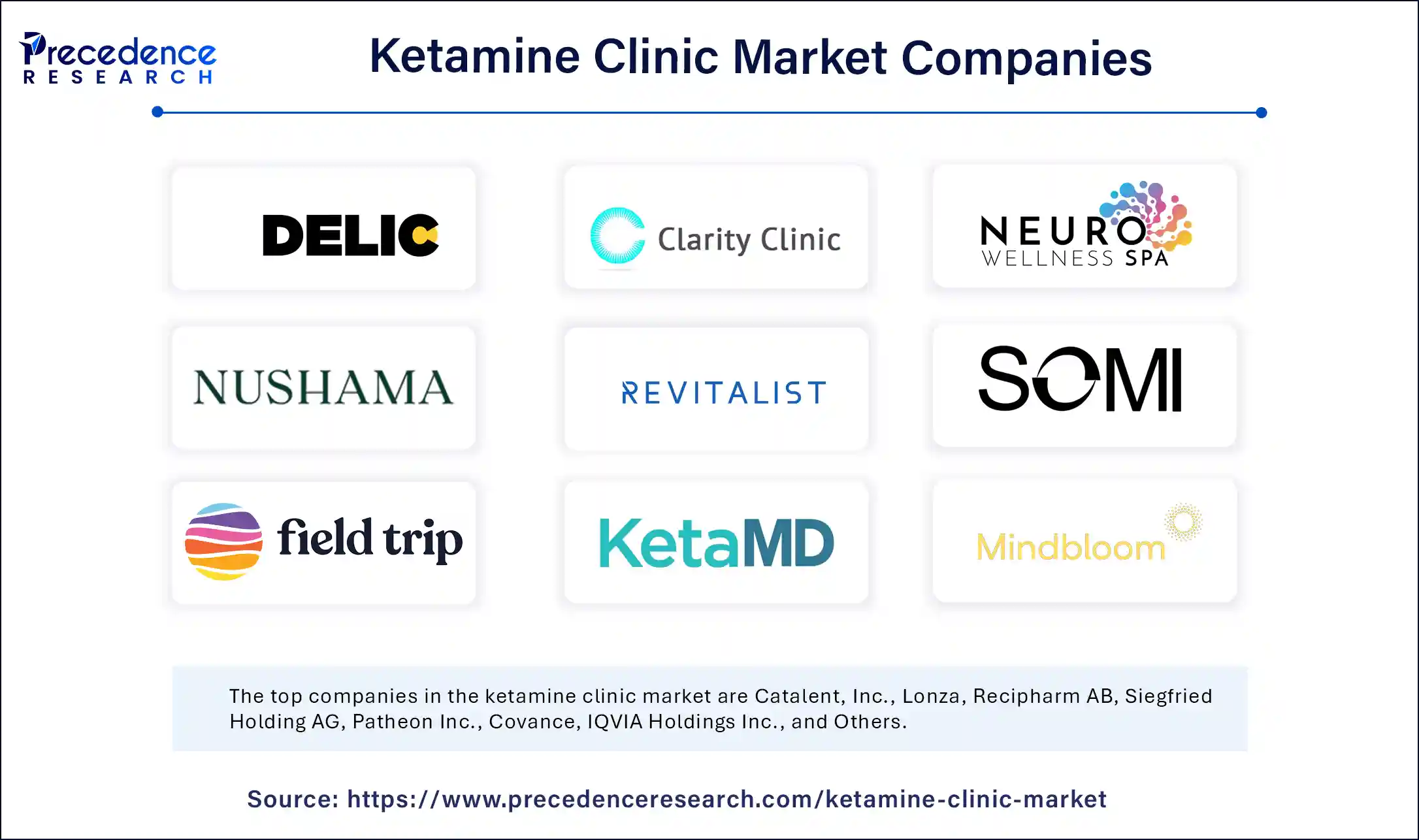
Ketamine Clinic Market Key Highlights
- North America dominated the global market with the largest market share of 47% in 2024.
- By region, Asia Pacific is expected to register the fastest CAGR between 2025 and 2024.
- By treatment type, the depression segment captured the biggest market share in 2024.
- By treatment type, the anxiety disorders segment is expected to grow at a significant CAGR over the forecast period.
- By route of administration, the intravenous segment contributed the highest market share in 2024.
- By route of administration, the oral segment is expected to expand to the fastest CAGR during the forecast period.
- By patient demographics, the adults segment has held the largest market share in 2024.
- By patient demographics, the geriatric segment is expected to grow at a rapid pace in the coming years.
Ketamine Clinic Overview
Ketamine clinics are specialized medical facilities that administer ketamine therapy—primarily for treating mental health conditions such as depression, anxiety, PTSD, and chronic pain. Originally used as an anesthetic, ketamine has gained attention for its rapid-acting antidepressant effects, especially in patients who are resistant to traditional treatments. These clinics provide carefully monitored infusions or nasal sprays (like esketamine) under professional supervision.
Services and Growing Demand:
Ketamine therapy typically involves a series of intravenous infusions over several weeks, with follow-up maintenance sessions as needed. Some clinics also offer complementary treatments like psychotherapy, integrative medicine, and wellness support. The demand for ketamine clinics is rising due to increasing mental health awareness and the need for alternative treatments. However, it remains a controlled substance, and clinics must follow strict protocols to ensure safety, proper dosing, and ethical use.
Growth Drivers in the Ketamine Clinic Market
Rising Demand for Mental Health and Pain Management
Ketamine clinics are experiencing rapid expansion due to the growing prevalence of treatment-resistant depression, anxiety, PTSD, and chronic pain. Patients and physicians increasingly recognize the speed at which ketamine can alleviate symptoms—often within hours—compared to traditional therapies that may take weeks. The mental health crisis, exacerbated by recent events, has heightened demand for effective alternatives. This urgency has prompted substantial investment in new clinics, telehealth platforms, and in-clinic infusion services, driving significant market growth, with CAGR projections exceeding 9–11% through the next decade in the U.S. market alone.
Regulatory Momentum and Technological Innovation
Regulatory approval of esketamine nasal spray marked a major milestone, increasing clinical legitimacy and reducing stigma, thereby encouraging expansion in off-label ketamine treatments. Innovations in delivery methods—ranging from intravenous and intranasal to oral and sublingual formulations—are broadening patient access and improving convenience. Additionally, telemedicine integrations and remote-guided therapy enable clinics to reach underserved and geographically remote populations. These factors collectively support stronger adoption rates across mature and emerging regions, reinforcing the sustainability of clinic growth.
Get this report to explore global market size, share, CAGR, and trends, featuring detailed segmental analysis and an insightful competitive landscape overview@ https://www.precedenceresearch.com/ketamine-clinic-market
Market Scope
| Report Coverage | Details |
| Market Size by 2034 | USD 3.35 Billion |
| Market Size in 2025 | USD 1.52 Billion |
| Market Size in 2024 | USD 1.39 Billion |
| Market Growth Rate from 2025 to 2034 | CAGR of 9.20% |
| Dominating Region | North America |
| Fastest Growing Region | Asia Pacific |
| Base Year | 2024 |
| Forecast Period | 2025 to 2034 |
| Segments Covered | Treatment Type, Route of Administration, Patient Demographics and Region |
| Regions Covered | North America, Europe, Asia-Pacific, Latin America, and Middle East & Africa |
Market Dynamics
Market Drivers
The ketamine clinic market is witnessing notable growth driven by the rising prevalence of treatment-resistant mental health conditions, particularly depression, anxiety, post-traumatic stress disorder (PTSD), and chronic pain syndromes. As conventional pharmacological therapies often fail to deliver effective outcomes for many patients, ketamine—a fast-acting dissociative anesthetic with antidepressant properties—has gained attention for its rapid and sustained therapeutic effects.
This has spurred the establishment of specialized ketamine clinics offering intravenous (IV), intramuscular, and nasal spray treatments. Increasing clinical evidence supporting ketamine’s efficacy in treating mood disorders and suicidality is enhancing its acceptance among mental health professionals. Furthermore, growing awareness about mental health, decreasing social stigma, and increased willingness of patients to explore alternative therapies are driving market growth, particularly in urban and high-income populations.
Opportunities
There are significant opportunities in expanding ketamine clinic services across underserved and emerging markets where access to advanced psychiatric care is limited. The increasing openness to psychedelic-assisted therapies and the broader shift toward personalized and integrative mental healthcare create a favorable environment for the growth of ketamine-assisted psychotherapy. Advancements in telemedicine and digital health are enabling clinics to integrate remote mental health consultations and follow-ups, thereby improving treatment adherence and patient monitoring.
Additionally, collaborations between ketamine clinics and research institutions may further propel clinical trials and support insurance reimbursement through evidence-based validation. As regulatory landscapes evolve to become more accommodating, there is also scope for expanding treatment indications and integrating ketamine therapies into mainstream healthcare models.
Challenges
Despite growing demand, the ketamine clinic market faces several challenges. Regulatory uncertainty and inconsistent legal frameworks across countries and states make it difficult for providers to operate uniformly. The classification of ketamine as a controlled substance in many regions adds a layer of scrutiny and operational burden. High treatment costs and limited insurance coverage act as barriers for many patients, especially for long-term or repeated dosing protocols.
Concerns about potential side effects, dependency risks, and misuse of ketamine continue to hinder broader acceptance, particularly in more conservative medical circles. Furthermore, the lack of standardized clinical guidelines and variability in treatment protocols among clinics can compromise treatment quality and outcomes. Building trust with the medical community and the public remains a significant hurdle, especially as commercial expansion outpaces clinical validation in some cases.
Regional Outlook
North America currently dominates the ketamine clinic market, with the United States at the forefront due to a combination of high demand for mental health services, relatively liberal clinical practices, and a large number of private ketamine treatment centers. Canada is also emerging as a supportive environment, especially with growing interest in psychedelic medicine and favorable regulatory discussions. Europe is gradually adopting ketamine therapy, led by countries like the UK, Germany, and the Netherlands, where mental health innovation and openness to alternative treatments are gaining traction, although strict regulations slow expansion.
The Asia-Pacific region offers long-term growth potential, particularly in countries like Australia and South Korea, which are showing early signs of interest in psychedelic-based mental healthcare. However, broader adoption in Asia is hindered by stringent drug laws and societal stigma. Latin America and the Middle East & Africa are nascent markets with limited access to ketamine clinics, though interest is rising as mental health awareness increases and global research highlights the therapy’s benefits.
Ketamine Clinic Market Companies

- The Answers Clinic
- Delic Holdings
- Ketamine Wellness Centers
- The Ketamine Clinic
- Clarity Clinic
- Neuro Wellness Spa
- New Mind Health
- Revitalist Lifestyle and Wellness
- Somi Vitamin
- Psychedelic Science
- Nushama
- KetaMD
- Field Trip Health
- Mindbloom
Segments Covered in the Report
By Treatment Type
- Depression
- Anxiety disorders
- Post-traumatic stress disorder
- Chronic pain
- Substance use disorders
By Route of Administration
- Intravenous
- Intramuscular
- Nasal
- Oral
- Sublingual
By Patient Demographics
- Adults
- Children
- Geriatric
- Veterans
- Pregnant women
By Region
- North America
- Asia-Pacific
- Europe
- Latin America
- Middle East & Africa
Also Read: eHealth 2.0 Market
You can place an order or ask any questions, please feel free to contact at sales@precedenceresearch.com|+1 804 441 9344